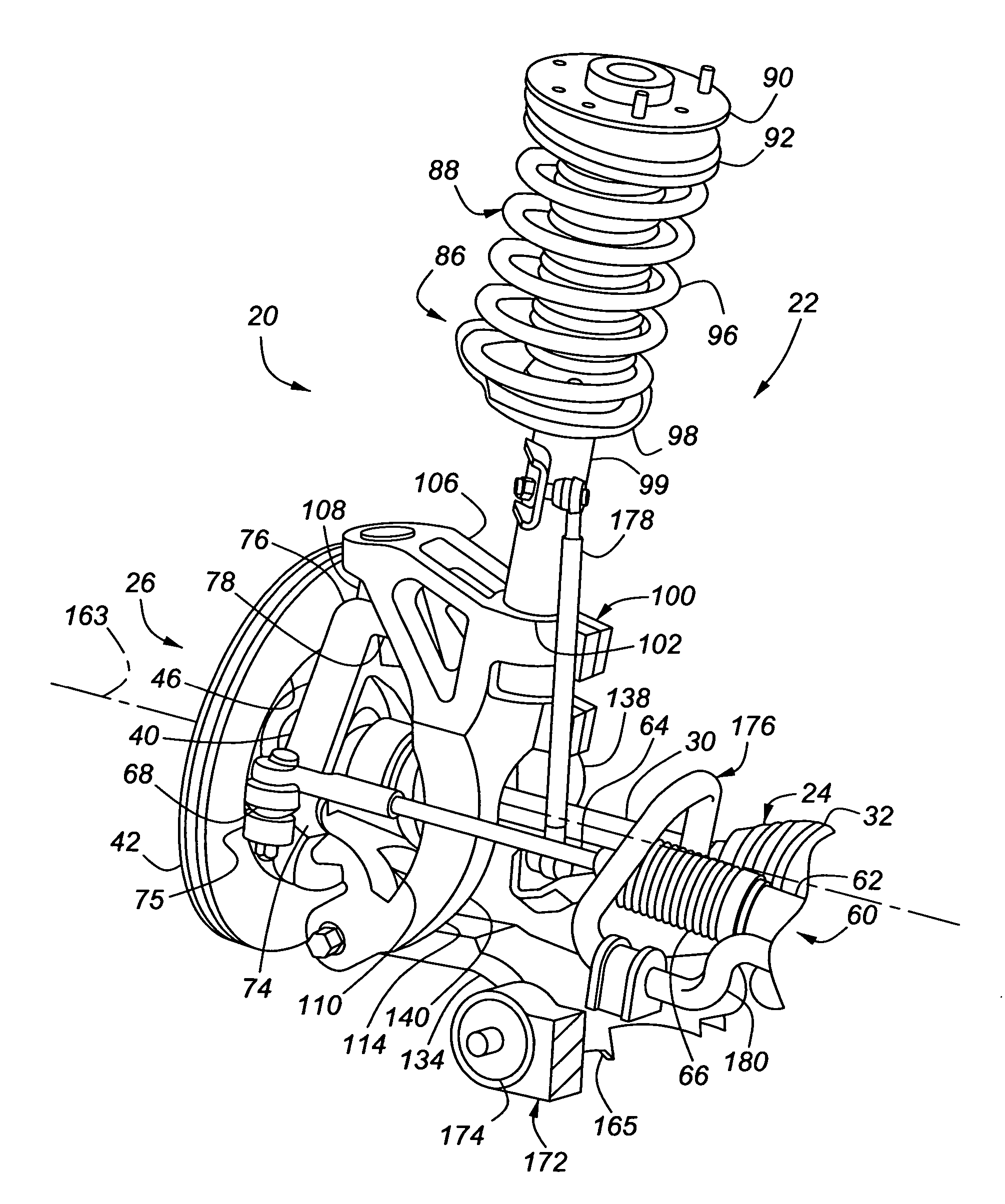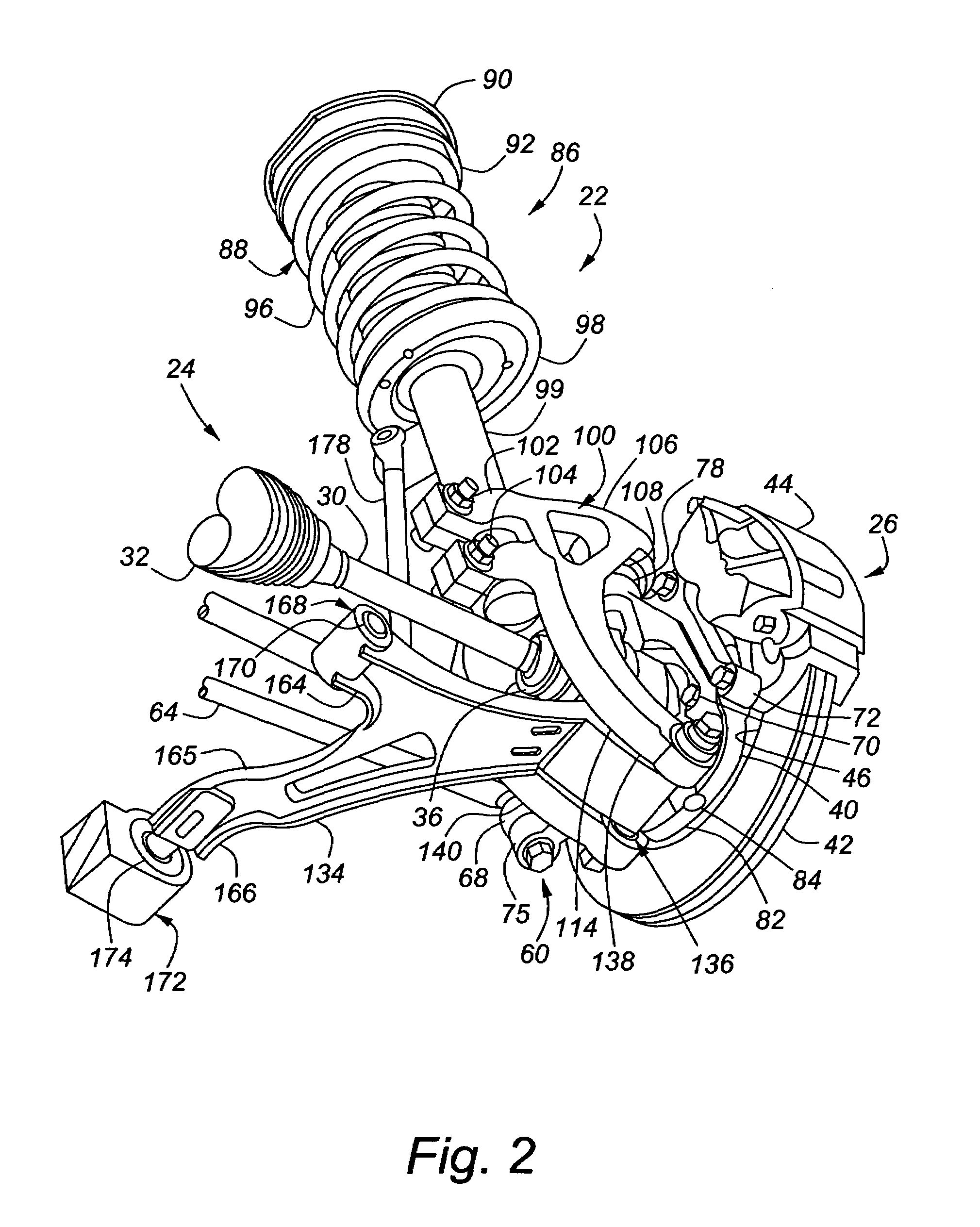Steering and suspension system for a vehicle
a steering and suspension system technology, applied in suspensions, resilient suspensions, vehicle components, etc., can solve the problems of increasing the load affecting the stability so as to reduce the impact isolation of the road profile, reduce the impact of the steering system, and improve the effect of traction steering concerns that may arise during combined acceleration and turn events
- Summary
- Abstract
- Description
- Claims
- Application Information
AI Technical Summary
Benefits of technology
Problems solved by technology
Method used
Image
Examples
first embodiment
[0024]Referring now to FIGS. 1-8, which illustrate the present invention, a portion of steering and suspension system 22, as would be employed on a front left corner of a vehicle 20, are shown. While these figures only illustrate the front left portion, the front right portion is essentially the same and so will not be illustrated herein. The steering and suspension system 22 cooperates with a driveline system, indicated generally at 24, a braking system, indicated generally at 26, and a wheel and tire assembly, indicated generally at 28.
[0025]The driveline system 24 includes a half shaft 30 connected at an inboard end to a transaxle (not shown) via a first constant velocity (CV) universal joint 32. An outboard end of the half shaft 30 connects to a drive axle 34 via a second CV joint 36. Wheel bearings 35 mount about a wheel hub 38 that surrounds the drive axle 34 and allow the half shaft 30 to cause the wheel hub 38 and wheel and tire assembly 28 to rotate relative to the suspensi...
second embodiment
[0039]Referring now to FIG. 9, a compliant hinge joint 236 in accordance with the present invention is shown. In this embodiment, the compliant hinge joint 236 connecting the two arms 238, 240 of the extension fork 214 to the lower control arm 234 is made up of two spaced apart bushings 242, 246, rather than one bushing and one ball joint. A forward thrust washer 252 is mounted about the pivot bolt 258 between the forward arm 238 of the extension fork 214 and the lower control arm 234, and a rear thrust washer 256 is mounted about the pivot bolt 258 between the rearward arm 240 of the extension fork 214 and the lower control arm 234. As an option, the thrust washers 252, 256 can be formed integral with the lower control arm 234, if so desired. Also, optionally, there may be an additional thrust washer (not shown) on the forward side of the bushing 246 and / or an additional thrust washer (not shown) on the rear side of the bushing 242, in order to distribute the load transfer at braki...
third embodiment
[0041]Referring now to FIG. 10, a lower joint assembly 312 between the lower support arms 310 of the strut extension member 300 and the lower arm 382 of the steering knuckle 340 in accordance with the present invention is shown. In this embodiment, the lower support arms 310 extend into a cavity 383 in the lower arm 382, with a ball joint portion 328 of the lower joint assembly 312 secured in a through-hole 324 in the lower support arms 310. The pin 330 of the rotating joint portion 326 extends through receptacles 384 in the lower arm 382, which are both above and below the lower support arms 310, as well as extending through the ball joint portion 328.
PUM
 Login to View More
Login to View More Abstract
Description
Claims
Application Information
 Login to View More
Login to View More - R&D
- Intellectual Property
- Life Sciences
- Materials
- Tech Scout
- Unparalleled Data Quality
- Higher Quality Content
- 60% Fewer Hallucinations
Browse by: Latest US Patents, China's latest patents, Technical Efficacy Thesaurus, Application Domain, Technology Topic, Popular Technical Reports.
© 2025 PatSnap. All rights reserved.Legal|Privacy policy|Modern Slavery Act Transparency Statement|Sitemap|About US| Contact US: help@patsnap.com



